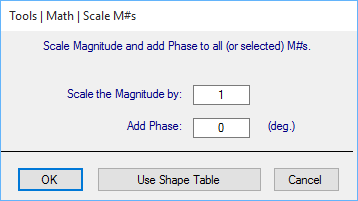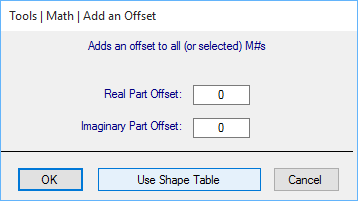
Multiplies all (or selected) M#s by a magnitude and adds phase to them.

The Use Shape Table button scales each M# with a different scale factor from a Shape Table.
The magnitude & phase of each M# of the first shape in the Shape Table is used to scale each matching M# in the Data Block
Adds a complex (real & imaginary) offset to all (or selected) M#s.

The Use Shape Table button adds a different offset from a Shape Table to each M#.
The complex value for each M# of the first shape in the Shape Table is used to offset each matching M# in the Data Block.
Adds random noise to each M#. The amount of random noise is a percentage of the maximum magnitude of each M#.
Replaces each complex measurement value with its complex conjugate. The Real part remains the same and the Imaginary part is multiplied by "-1".
Replaces each M# with its inverse.
Replaces each M# with its value squared.
Replaces each M# with the square root of its value.
Performs multi-point smoothing of each measurement in a Data Block. Replaces each measurement sample with the average value of N samples of data surrounding that sample.
For example, for N = 3,
M# (sample) = (M# (sample) + M# (sample-1) + M# (sample +1) ) / 3
Changes the number of samples in a Data Block without changing the X-Axis span by re-sampling the measurements
Sums all (or selected) M# values at each sample and stores the result into a single M#.
Divides the sum of all (or selected) M# values at each sample by the number of M#s, and stores the result into a single M#.
Performs the indicated operation between the M#s in a Data Block and a selected M# in the same of a different Data Block..
If two Data Blocks have the same number of M#s in them, you can choose to perform the operation between M# pairs in the two Data Blocks.